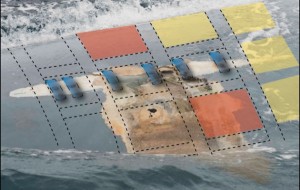Matthew Sheahan takes a look at some of the key findings of the Marine Accident Investigation Branch from a report following last year’s tragedy in which all four crew were lost
The 65-page MAIB report (download here) is a thorough investigation into a tragic and particularly difficult case given the lack of hard evidence and survivors. Nevertheless, its findings and analysis provide considerable food for thought for the industry and participants alike highlighting both construction techniques and some of the assumptions that we make.
Aside from the obvious tragedy in the loss of four men, it is perhaps that Cheeki Rafiki was a typical and popular cruiser/racer being operated no differently to many boats of her size and type. Whether we were chartering or not, most of us have probably been guilty at some time of brushing a grounding incident under the carpet and/or not having detailed inspections carried out afterwards.
This report highlights the importance of having a structured maintenance and inspection programme and procedures for crisis management should problems start to occur.
Most harrowing of all in this particular incident is how quickly a situation can change aboard a boat that had all the correct safety kit from uncomfortable to fatal.
TAKING ON WATER
Considering the circumstances that led to the capsize, the report sets out the communications between the skipper and the principal director of Stormforce Coaching, the company that operated the boat. Those communications were a combination of emails, text messages and phone calls.
The last email from the boat at 2022 Thursday 15 May read, ‘we have been taking on a lot of water yesterday and today. Today seems worse
I think stbd water tank has split so that is drained checked hull and sea cocks for damage but cant see any.’
‘Any thoughts from your end I will check emails in 2 hours’
But no more emails were received by Cheeki Rafiki despite Stormforce Coaching asking if the water was; ‘fresh or salty, along with advice to, ‘Loosen straps for liferaft. Check EPIRB and sat phone are accessible etc. Have everything ready in case of worst case.’
Two hours after the last email correspondence there was a satellite telephone voice call from the skipper to Stormforce Coaching in which Bridge described the situation as, ‘worse than before and that
the water had been identified as sea water, the engine bilge had been found to be dry and that the leak could not be found.’
Shortly afterwards and clearly gravely concerned at the situation, Stormforce Coaching sent an email offering detailed guidance as to how to search for a possible leak as well as advice on preparation for an emergency.
The email was never received. The last communication with the boat was via the boat’s satellite phone. The transmission was difficult to read and just 1min 42 secs at 0330 on Friday 16 in which the skipper was understood to say, ‘this is getting worse.’
No further communications were successful.
Next page: How and why the keel failed





